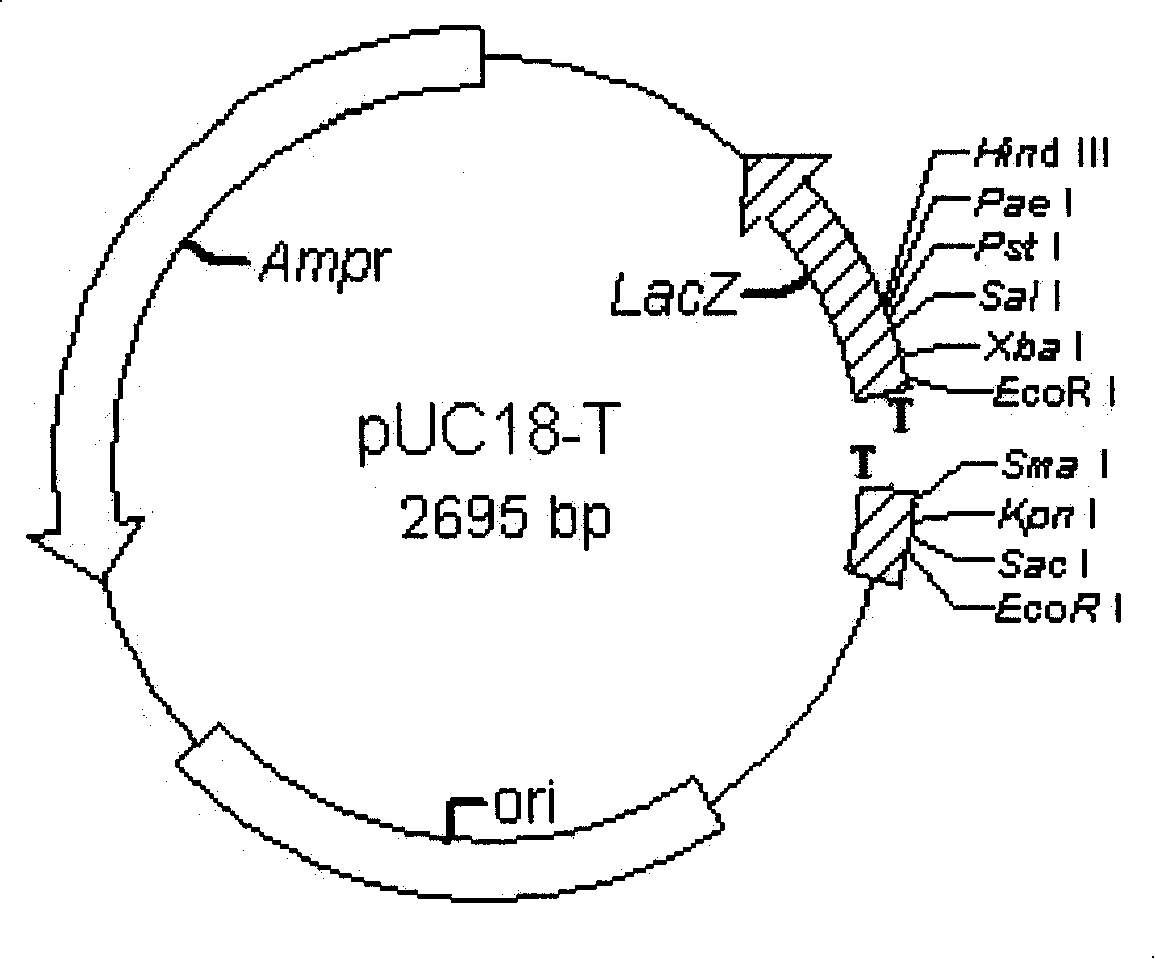Method for high-effective construction of T-carrier based on polymerase chain reaction
A carrier and high-efficiency technology, applied in the direction of using vectors to introduce foreign genetic material, recombinant DNA technology, etc., can solve the problems of high non-recombination background of enzymes, low enzyme digestion efficiency, low cloning efficiency, etc., and achieve simple and easy experimental steps, cloning The effect of high efficiency and simple method
- Summary
- Abstract
- Description
- Claims
- Application Information
AI Technical Summary
Problems solved by technology
Method used
Image
Examples
Embodiment 1
[0031] Example 1: Preparation of T vector pUC18-T
[0032] 1. Preparation of plasmid pUC18-V
[0033] According to the sequence of plasmid pUC18, a pair of oligonucleotide sequences were designed as:
[0034] pUC-oligo-s: 5' AATT CGAGCTCGGTACCCGGG GATATC G CCCTCTAGAG-3';
[0035] pUC-oligo-as: 5' TCGA CTCTAGAGGGG C GATATC CCCGGGTACCGAGCTCG-3'.
[0036] The introduced oligonucleotide sequences all contain (1) EcoRI recognition site, marked in italics; (2) EcoRV recognition site, marked with a single line; in addition, the 5' ends of the two oligonucleotides contain EcoRI respectively Cut end "AATT" and SalI cut end "TCGA".
[0037] The oligonucleotide fragments were phosphorylated separately, and the two reaction systems were 20 μL, containing 1U T 4 DNA kinase, 1×T 4 DNA kinase Buffer, pUC-oligo-s or pUC-oligo-as 5μmol / L, ATP final concentration 1mmol / L. After acting at 37°C for 60 minutes, mix the two systems, and inactivate T at 70°C for 10 minutes 4 For D...
Embodiment 2
[0047] Example 2: Efficiency Detection of T Vector pUC18-T
[0048] Use TaqDNA polymerase to amplify the minimal promoter of chemokine receptor CXCR4, and perform ligation reaction between CXCR4 PCR product and pUC18-T vector. The 10 μL ligation system is as follows: 25ng PCR product, 50ng T vector, 3U T 4 DNA ligase, ligated for 16 hours at 16°C. The above-treated ligation product was transformed into JM109 strain. After picking 20 clones and culturing them, the plasmids were extracted and digested with EcoRI (one EcoRI site on each side of the A-T cloning site) to identify the presence or absence of the insert. The results showed that the transformation efficiency of T vector clones was not lower than 5×10 5 cfu / mg DNA, all clones picked contain inserts. The recombinant vectors were named pUC18-T / CXCR4 respectively.
PUM
 Login to View More
Login to View More Abstract
Description
Claims
Application Information
 Login to View More
Login to View More - R&D
- Intellectual Property
- Life Sciences
- Materials
- Tech Scout
- Unparalleled Data Quality
- Higher Quality Content
- 60% Fewer Hallucinations
Browse by: Latest US Patents, China's latest patents, Technical Efficacy Thesaurus, Application Domain, Technology Topic, Popular Technical Reports.
© 2025 PatSnap. All rights reserved.Legal|Privacy policy|Modern Slavery Act Transparency Statement|Sitemap|About US| Contact US: help@patsnap.com

